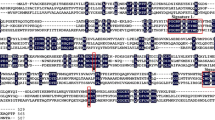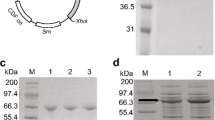Abstract
In this paper, a molecularly directed evolution-based approach was applied to modify the nitrilase from Rhodococcus rhodochrous tg1-A6 for improving properties in catalyzing nitriles. In the process of error-prone polymerase chain reaction (PCR) with the wild-type nitrilase gene acting as the template, a library of the randomly mutated nitrilase gene was constructed. Since the pH value of catalyzing solution decreased when glycolonitrile was used as the substrate of nitrilase, a high-throughput strategy based on the color change of a pH-sensitive indicator was established for rapid screening of the mutated nitrilase. After three rounds of random mutation and screening about 5000 clones, a variant (Mut3) with 5.3-fold activity of the wild-type counterpart was obtained. Five amino acid substitutions (D27E, N97K, L246F, D108E, and S111R) were found in the variant Mut3. The properties of three mutated enzymes obtained in the three-round mutation were investigated. In the conversion of glycolonitrile, the variant (Mut2) accumulated the highest concentration of glycolic acid at 10.6 g l−1, a much higher value than the wild type (3.2 g l−1).









Similar content being viewed by others
References
He, Y. C., Xu, J. H., Su, J. H., & Zhou, L. (2010). Bioproduction of glycolic acid from glycolonitrile with a new bacterial isolate of Alcaligenes sp. ECU0401. Applied Biochemistry and Biotechnology, 160, 1428–1440.
Debabov, V. G., & Yanenko, A. S. (2011). Biocatalytic hydrolysis of nitriles. Review Journal of Chemistry, 1, 385–402.
Fernandes, B. C. M., Mateo, C., Kiziak, C., Chmura, A., Wacker, J., van Rantwijk, F., Stolz, A., & Sheldon, R. A. (2006). Nitrile hydratase activity of a recombinant nitrilase. Advanced Synthesis and Catalysis, 348, 2597–2603.
Komeda, H., Hori, Y., Kobayashi, M., & Shimizu, S. (1996). Transcriptional regulation of the Rhodococcus rhodochrous J1 nitA gene encoding a nitrilase. Proceedings of the National Academy of Sciences of the United States of America, 93, 10572–10577.
Sharma, N. N., Sharma, M., & Bhalla, T. C. (2011). An improved nitrilase-mediated bioprocess for synthesis of nicotinic acid from 3-cyanopyridine with hyperinduced Nocardia globerula NHB-2. Journal of Industrial Microbiology and Biotechnology, 38, 1235–1243.
Zhang, Z. J., Xu, J. H., He, Y. C., Ouyang, L. M., & Liu, Y. Y. (2011). Cloning and biochemical properties of a highly thermostable and enantioselective nitrilase from Alcaligenes sp. ECU0401 and its potential for (R)-(-)-mandelic acid production. Bioprocess and Biosystems Engineering, 34, 315–322.
Sun, H., Gao, W., Fan, H., Wang, H., & Wei, D. (2015). Cloning, purification and evaluation of the enzymatic properties of a novel arylacetonitrilase from Luminiphilus syltensis NOR5-1B: a potential biocatalyst for the synthesis of mandelic acid and its derivatives. Biotechnology Letters, 37, 1655–1661.
Schreiner, U., Hecher, B., Obrowsky, S., Waich, K., Klempier, N., Steinkellner, G., Gruber, K., Rozzell, J. D., Glieder, A., & Winkler, M. (2010). Directed evolution of Alcaligenes faecalis nitrilase. Enzyme and Microbial Technology, 47, 140–146.
He, Y. C., Ma, C. L., Xu, J. H., & Zhou, L. (2011). A high-throughput screening strategy for nitrile-hydrolyzing enzymes based on ferric hydroxamate spectrophotometry. Applied Microbiology and Biotechnology, 89, 817–823.
Luo, H., Fan, L., Chang, Y., Ma, J., Yu, H., & Shen, Z. (2010). Gene cloning, overexpression, and characterization of the nitrilase from Rhodococcus rhodochrous tg1-A6 in E. coli. Applied Biochemistry and Biotechnology, 160, 393–400.
Dalby, P. A. (2011). Strategy and success for the directed evolution of enzymes. Current Opinion in Structural Biology, 21, 473–480.
Goldsmith, M., & Tawfik, D. S. (2012). Directed enzyme evolution: beyond the low-hanging fruit. Current Opinion in Structural Biology, 22, 406–412.
Li, Y., & Cirino, P. C. (2014). Recent advances in engineering proteins for biocatalysis. Biotechnology and Bioengineering, 111, 1273–1287.
Griffiths, A. D., & Tawfik, D. S. (2006). Miniaturising the laboratory in emulsion droplets. Trends in Biotechnology, 24, 395–402.
Bershtein, S., & Tawfik, D. S. (2008). Advances in laboratory evolution of enzymes. Current Opinion in Chemical Biology, 12, 151–158.
Griffiths, A. D., Williams, S. C., Hartley, O., Tomlinson, I. M., Waterhouse, P., Crosby, W. L., Kontermann, R. E., Jones, P. T., Low, N. M., & Allison, T. J. (1994). Isolation of high affinity human antibodies directly from large synthetic repertoires. The EMBO Journal, 13, 3245–3260.
Fernandez-Gacio, A., Uguen, M., & Fastrez, J. (2003). Phage display as a tool for the directed evolution of enzymes. Trends in Biotechnology, 21, 408–414.
Arnold, F. H., & Georgiou, G. (2003). Directed enzyme evolution: screening and selection methods. ed., Humana, Totowa.
Xiao, Y., Huo, X., Qian, Y., Zhang, Y., Chen, G., Ouyang, P., & Lin, Z. (2014). Engineering of a CPC acylase using a facile pH indicator assay. Journal of Industrial Microbiology and Biotechnology, 41, 1617–1625.
Banerjee, A., Kaul, P., Sharma, R., & Banerjee, U. C. (2003). A high-throughput amenable colorimetric assay for enantioselective screening of nitrilase-producing microorganisms using pH sensitive indicators. Journal of Biomolecular Screening, 8, 559–565.
Studier, F. W. (2005). Protein production by auto-induction in high-density shaking cultures. Protein Expression and Purification, 41, 207–234.
Zhang, L., Yin, B., Wang, C., Jiang, S., Wang, H., Yuan, Y. A., & Wei, D. (2014). Structural insights into enzymatic activity and substrate specificity determination by a single amino acid in nitrilase from Syechocystis sp. PCC6803. Journal of Structural Biology, 188, 93–101.
Martinkova, L., & Kren, V. (2010). Biotransformations with nitrilases. Current Opinion in Chemical Biology, 14, 130–137.
Voigt, C. A., Mayo, S. L., Arnold, F. H., & Wang, Z. G. (2001). Computational method to reduce the search space for directed protein evolution. Proceedings of the National Academy of Sciences of the United States of America, 98, 3778–3783.
Morley, K. L., & Kazlauskas, R. J. (2005). Improving enzyme properties: when are closer mutations better? Trends in Biotechnology, 23, 231–237.
Tollinger, M., Crowhurst, K. A., Kay, L. E., & Forman-Kay, J. D. (2003). Site-specific contributions to the pH dependence of protein stability. Proceedings of the National Academy of Sciences of the United States of America, 100, 4545–4550.
Acknowledgments
This work was supported by the National Science Foundation of China (21276023; 21476025).
Author information
Authors and Affiliations
Corresponding author
Rights and permissions
About this article
Cite this article
Luo, H., Ma, J., Chang, Y. et al. Directed Evolution and Mutant Characterization of Nitrilase from Rhodococcus rhodochrous tg1-A6. Appl Biochem Biotechnol 178, 1510–1521 (2016). https://doi.org/10.1007/s12010-015-1964-9
Received:
Accepted:
Published:
Issue Date:
DOI: https://doi.org/10.1007/s12010-015-1964-9




